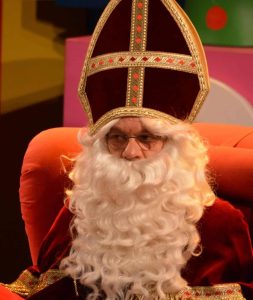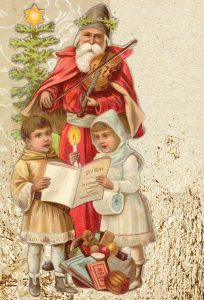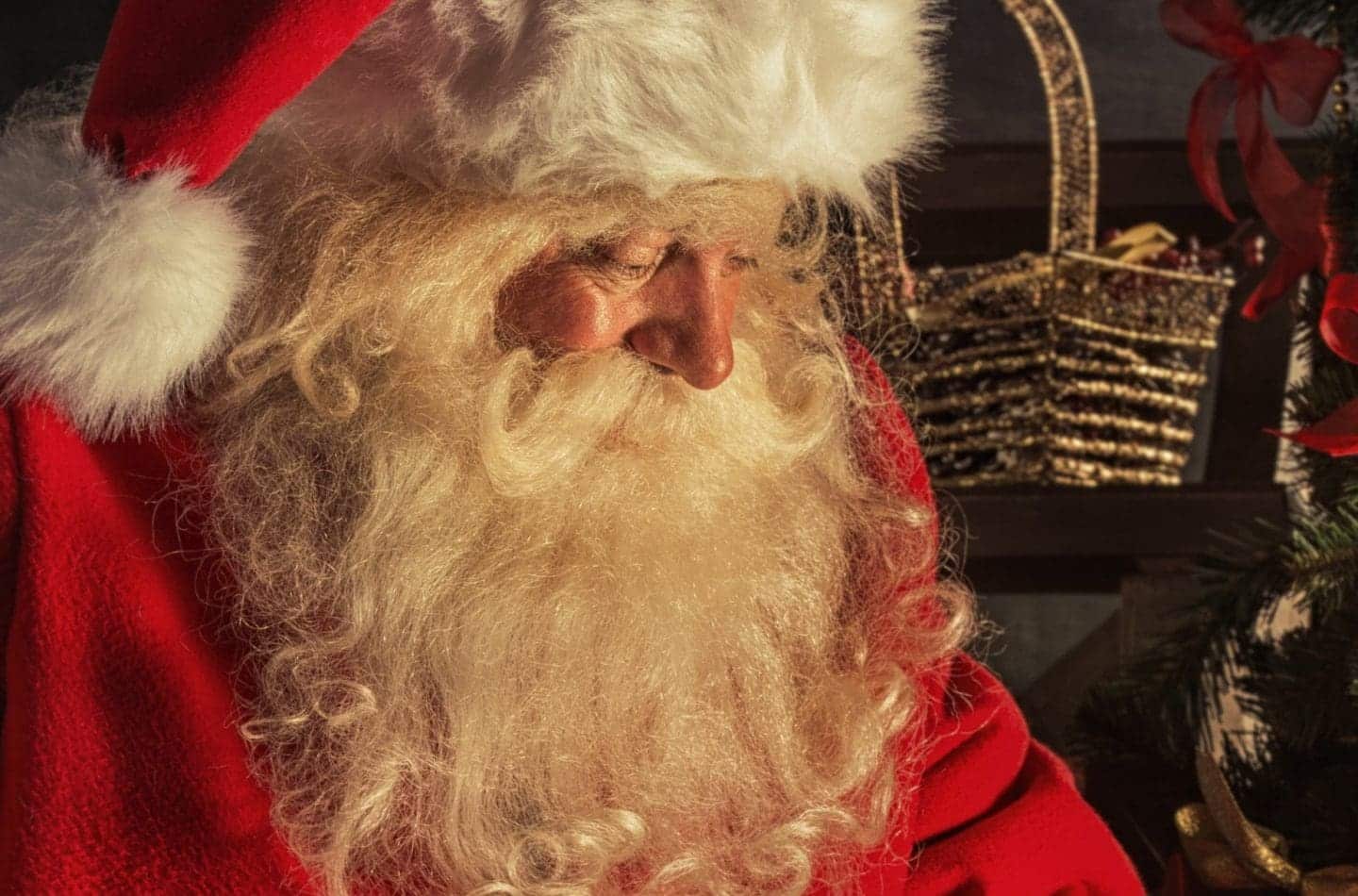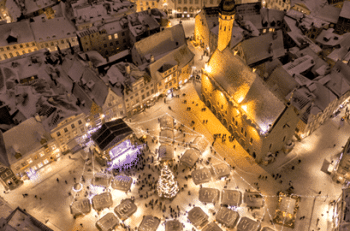From jolly old man to winter sprite, Father Christmas has taken many forms over the centuries. But how did this allegorical figure become the iconic symbol of the festivities we know and love today?
Who is Father Christmas?

In the early days of Christmas celebrations, Father Christmas wasn’t very child-friendly, he was often shown as a mischievous merrymaker who presided over raucous festive celebrations.
In the 15th century a personality that can be likened to Father Christmas first appeared in a carol. The song tells of ‘Sir Christëmas’ sharing the news of the birth of Christ and urging everyone to “Make good cheer and be merry“.
In York, another possible precursor to Father Christmas was celebrated in a festival called the ‘Yule Ridings.’ It took place on December 21st and featured a man disguised as Yule – usually a man-sized goat – carrying meat and cake through the streets and throwing nuts into the crowd. However, in 1572, the event was banned due to complaints of ‘very rude and barbarous’ behaviour.
Later, in Tudor and Stuart times, the ‘Lord of Misrule’ oversaw Christmas festivities in aristocratic homes. Other names included ‘Prince Christmas’, ‘The Christmas Lord’ and ‘Captain Christmas’. In none of these depictions was he an old man with a white beard.
It was playwright Ben Johnson who crafted a yuletide performance for the royal court in 1616 that portrayed Father Christmas for the first time as an old man and a father.
Johnson’s character appeared in old-fashioned clothes, sported a long thin beard and was accompanied by several of his children, each personifying a tradition from the period.
For example, one child would be ‘Carol’ and another would be ‘Mince Pie’. Father Christmas didn’t bring gifts but his one son was called ‘New Yeares Gift’ and brought with him an ‘Orange, a sprig of Rosemarie’ and a ‘coller of gingerbread’ and a ‘bottle of wine on either arme’.
During the English Civil War, criticism of Christmas by Puritans increased, this led to Parliament banning Christmas altogether in 1647.
Shown with a fur-trimmed, old-fashioned gown and a white beard
In 1658, in a story called ‘The Examination and Tryall of Old Father Christmas’, our festive friend was shown as having a fur-trimmed, old-fashioned gown and a white beard. In the story, he is put on trial for his life but was – thankfully for us! – acquitted by the jury.
After the Restoration in 1660, Father Christmas reappeared and became a mainstay of stage plays for the next 200 years.
He then enjoyed another mini renaissance in the first half of the 19th century, when he appeared in some popular illustrations which showed him to be a winter sprite wearing a holly garland on his head and gorging on lots of drink and food.
As Christmas became more focused on family and children during the Victorian era, a new kind of Father Christmas emerged. This version was less about drinking, feasting, and making merriment and more about giving gifts to children.
Today, Father Christmas is synonymous with Christmas cheer, gift-giving and spreading joy to all. He’s become an integral part of our festive traditions and has evolved alongside the changing times.
oooOooo
The History of Father Christmas in English Folklore
This is a great video from Allan Barton about the history of Father Christmas.
As Allan says, he’s a bit like Santa but has ‘rather different origin and function’ in our festivities.
Starting in the Middle Ages as Sir Christmas, he is the spirit and personification of Christmas. He is part of the separate folk tradition of Yule.
In the 17th century, Sir Christmas was banned by Puritans but revived again in the Restoration.
And Charles Dickens reinvents Father Christmas as the Ghost of Christmas Present with a green fur-trimmed robe.
This is an interesting take and the Christmas.co.uk team rather like the sound of the raucous celebrations in York…
oooOooo
So, who are St Nicholas and Sinterklaas?

Sinterklaas’ origins go back to St Nicholas, a 4th-century Greek bishop known for his miraculous deeds. One story tells of how he resurrected three youths that had been murdered and left in a pickling barrel. He also anonymously poured three bags of gold down the chimney of a man’s house so he could provide a dowry for each of his daughters. The gold fell into stockings that the girls had left to dry by an open fire – a tradition that would later inspire hanging stockings for Christmas.
St Nicholas’s reputation spread after 1087 when his relics were moved to Italy. Over time, the stories about generously providing gold to those in need led to the tradition of leaving gifts on the evening before St Nicholas’s Day, the 6th of December. This is also when Sinterklaas entertainers would don red bishops’ outfits to delight crowds and special markets sold toys and treats for the occasion.
But like Father Christmas, Sinterklaas was attacked by critics. One reason is that Protestants were looking to move away from the veneration of saints, and they wanted to promote the birth of Jesus as an appropriate time to give children gifts. So, this period saw St Nicholas markets being banned, along with the popular bishop-shaped biscuits they sold.
Many popular traditions surrounding Sinterklaas survived
Despite the ban, many popular traditions surrounding Sinterklaas survived. One famous portrayal is Jan Steen’s 17th-century painting, ‘The Feast of St. Nicholas,’ which illustrates a chaotic scene of feasting and gift-giving.
But it’s the expansion of the Sinterklaas story that highlights its dark origins. Frightening characters such as Krampus, Pelsnickel (‘Furry Nicholas’), and Pere Fouettard (‘Old Man Whipper’), were added to the tradition. These Machiavellian creatures dished out punishments to mischievous children, such as whipping or kidnapping them.
By modern standards, the Grinch – a modern day fictional character who hates Christmas – is relatively tame in comparison with the likes of the ‘Old Man Whipper’ and no-one gets kidnapped today.
As Europe evolved and spread its traditions, Sinterklaas eventually inspired the development of Father Christmas in England. While the two icons share similarities – such as delivering gifts to children – it’s clear that Father Christmas is far less frightening than his predecessor.
When you’re hanging your stockings and eagerly awaiting the arrival of Father Christmas this year, remember the dark legend that inspired the benevolent figure we know and love today.
oooOooo
History of St Nicholas, Sinterklaas, and Santa (and Odin?)
Here’s another great YouTube video this time from Mythology with Mike, that tries to unravel the link between St Nicholas, Sinterklaas and Santa. There is even a reference to Odin who some say is the real source of the Santa tradition.
The video tells how an early Christian saint was transformed into Santa.
Along the way, various European countries celebrated different versions – and then, ultimately, these variants morphed into the figure we know and love today.
oooOooo
And here comes Santa Claus
It’s the most wonderful time of the year – Christmas! And with that comes the joyous arrival of the other iconic festive figure – Santa Claus!
But hold your reindeer, did you know that the beloved man in red wasn’t always the jolly old elf we know and love today?
For many, Santa Claus and Father Christmas are different names for the same man. There are, however, some historical and cultural differences.
Santa Claus’ story begins with European immigrants bringing their traditions and tales of Saint Nicholas with them to North America and, eventually, the Dutch colony of New Amsterdam – now New York.
An article in Rivington’s Gazetteer in 1773, reported that the anniversary of St Nicholas – also known as ‘St a Claus’ – was being celebrated.
This was the first mention of Santa Claus in North America.
Fast forward to 1809, when Washington Irving wrote that Dutch families in New York were still telling tales of Sinterklaas on St Nicholas’s Day.
He revealed that their Santa flew in a wagon over the city and would climb down chimneys to deliver presents. This whimsical idea of flying and delivering presents stuck, and the legend took on a life of its own.
Santa wearing a red coat
Then in 1821, a poem called ‘Old Santeclaus with Much Delight’ was published that described Santa wearing a red coat, a riding a sleigh pulled by reindeer. By now, the traditional day for the delivery of presents had moved from St Nicholas’ Day to Christmas Eve.
Two years afterwards, Clement Clark Moore embellished the legend further in his poem ‘The Night Before Christmas’. This version of Santa was very different to the others, and he was now a ‘right jolly old elf’ with old clothes damaged by soot and ashes. He also had dimples, twinkling eyes, and a white beard.
As Santa’s legend continued to spread, the imagination of generations of artists and writers added to the story.
For most of the 19th century, Santa took on various forms – he was short or tall, thin or fat and his coat was a range of colours.
Thomas Nast, a cartoonist in the 1860s, was responsible for creating the look of our modern Santa. By 1881, he had perfected his vision in his ‘Merry Old Santa Claus’ story and the world learned about Santa’s workshop, the elves and his snowy home at the North Pole.
It’s also worth noting that it is a myth that Coca-Cola invented Santa, the fizzy-pop-pushers didn’t begin to use Santa to advertise their drinks until the 1930s.
From Saint Nicholas to the jolly old elf, we know and love today, Santa has evolved over the centuries.
And then Father Christmas met Santa Claus …

According to historians, Santa first appeared in England in 1864, co-starring with Father Christmas in a story by American author Susanna Warner. In her tale, Santa brought gifts while Father Christmas appeared in a pantomime-type of play.
Interestingly, fairies were also once known for their clandestine Christmas gift-giving during the 1860s. However, the legend of a gift-giving Santa Claus quickly became more popular than the fairies. This emerging tradition of Santa confused English folklorists in the 1870s. Edwin Lees, in a letter to Notes & Queries in 1879, described the practice of placing stockings outside the door of the bedroom in the hopes they would be filled with presents by the mythical being called ‘Santiclaus’. He pondered over who the benevolent figure could be.
By the 1880s, Santa Claus had merged with Father Christmas to become a beloved character across England. In fact, a French visitor in 1883 noted that it was common knowledge that Father Christmas went down chimneys to fill stockings with toys and sweets.
Santa had been ‘invented’ by New Yorkers who had in turn been inspired by their Dutch neighbours. He was then embraced by Victorians searching for a family-friendly tradition to share at Christmas.
By the end of the 19th century, Punch magazine had depicted two versions of the gift giver extraordinaire. ‘Father Christmas not-up-to-date’ was an outdated figure focused solely on festive food, while ‘Father Christmas up-to-date’ was a modern, car-driving figure delivering fun toys. The English Father Christmas had now almost completely evolved into the American Santa Claus in all but name.
Thus, Santa Claus journeyed in his sleigh across the Atlantic to become a beloved character in English folklore. While he started as a mere character in a story, he quickly became a symbol of love, generosity, and kindness during the festive season.
oooOooo
The Untold Story of Father Christmas
How a toymaker became a father to children around the world?
From LaplandUK, this video helps explain how Father Christmas is a staple of our festive celebrations.
In it, Father Christmas reads a story for children about how he came into being – and how he is such an iconic figure today.
The blurb says this is the continuation of a tradition of Father Christmas reading the story to the elves about how a humble toymaker became a father figure to children around the world.
oooOooo
Father Christmas – the modern icon

Once plagued by boisterous behaviour led by the ‘Lord of Misrule’ and unruly children, the festivities were redefined by the Victorians as a time for children, religion and charity.
The era saw the birth of a family-friendly Christmas season and the reinterpretation of previous traditions.
The German Christmas tree, popularised by Prince Albert and Queen Victoria, became a permanent fixture in British homes, while the act of gift-giving shifted from New Year to Christmas.
Tom Smith’s invention of the Christmas cracker added an extra touch of surprise to the holiday gatherings.
The mass production of cards during the Victorian era helped to spread the festive spirit far and wide.
Also, carol singing experienced a revival, with both new songs and old classics making a comeback.
However, the Victorians of the ruling classes needed an alternative figure to Father Christmas, who was infamous for his love of parties. They sought a jolly and generous character dedicated to children and Santa Claus emerged as the perfect fit.
Nonetheless, the English still faced a challenge. The masses had their own hero in the form of Father Christmas, and they were initially unsure of who Santa Claus was.
As a result, the English Father Christmas was essentially rebranded as Santa Claus and he quickly became a beloved figure.
Today, Santa Claus remains the dominant symbol of Christmas all around the world, thanks to his origins as a character created by New Yorkers and his subsequent rise to popularity worldwide.
Through the Victorians’ reinvention of Christmas, Father Christmas has maintained his place as a popular figure, albeit one that is now interchangeable with Santa Claus.
Nevertheless, the festive season continues to celebrate family, generosity, and love – with the added bonus of a cheerful old man in a red suit who brings happiness to children everywhere.
Is Father Christmas real?
Of course, Santa Claus is real! Who would say he wasn’t? Who delivers all of those presents to children around the world every year?
The origins of Father Christmas start with the legend of Saint Nicholas in the third century who was known for his generosity and kindness. He was a Greek, living in the Roman Empire and his birthplace, Patara, is now part of Turkey.
Over time, stories about Saint Nicholas were passed down through generations. His lifelong charity was often celebrated by gift giving on the anniversary of his death on 6 December.
In the 16th century, Father Christmas began appearing in England as a personification of the festive season. He was depicted as a jolly, rotund figure dressed in green robes trimmed with fur. He wasn’t yet associated with gift-giving but was instead seen as a symbol of good cheer and revelry.
How old is Father Christmas?
Determining Father Christmas’ age is a bit tricky.
While St Nicholas, the man who is the source of the legend was born in the third century, the medieval period saw the origins of a Father Christmas character, when he was known as the Lord of Misrule and someone acting in his name would be appointed to oversee the festivities of the Christmas season and engage in revelry and merry making.
The first known depiction of Father Christmas as a gift-giver was in a 17th-century with an image that bears a striking resemblance to the modern-day version of Father Christmas.
Does the age of Father Christmas matter? He is essentially timeless remains a much-loved symbol of the festive season and a reminder of the importance of generosity, kindness and joy.
What is Father Christmas’s address?

They might simply be curious, or they may want to write to him.
While his real home address is a closely kept secret, there are several ways children can get in touch with the jolly old man himself.
One popular way for children to contact Father Christmas is by writing to him via the Post Office.
You might like to know what the last posting day is for children in the UK who want to write to Father Christmas. The Royal Mail can help!
Another option for children looking to contact Father Christmas is to send him an email – there are several websites that offer this email contact details.
oooOooo
Letters to Father Christmas
Why did children in Britain start receiving replies from Santa?
This is a great video from The Postal Museum which explains how the tradition of writing to Santa – and expecting a reply – came about.
It explains the role of the Post Office in helping Santa to reply to children in the UK every year.
The earliest example of such a letter was in 1896, and a few years later the Post Office was dealing with thousands of letters.
A legal obligation to deliver letters, even to Toyland and Lapland, meant a solution had to be found.
And with ever-growing numbers of children writing, the Post Office began helping Santa with his replies!
The video is not only informative, but great fun too!





